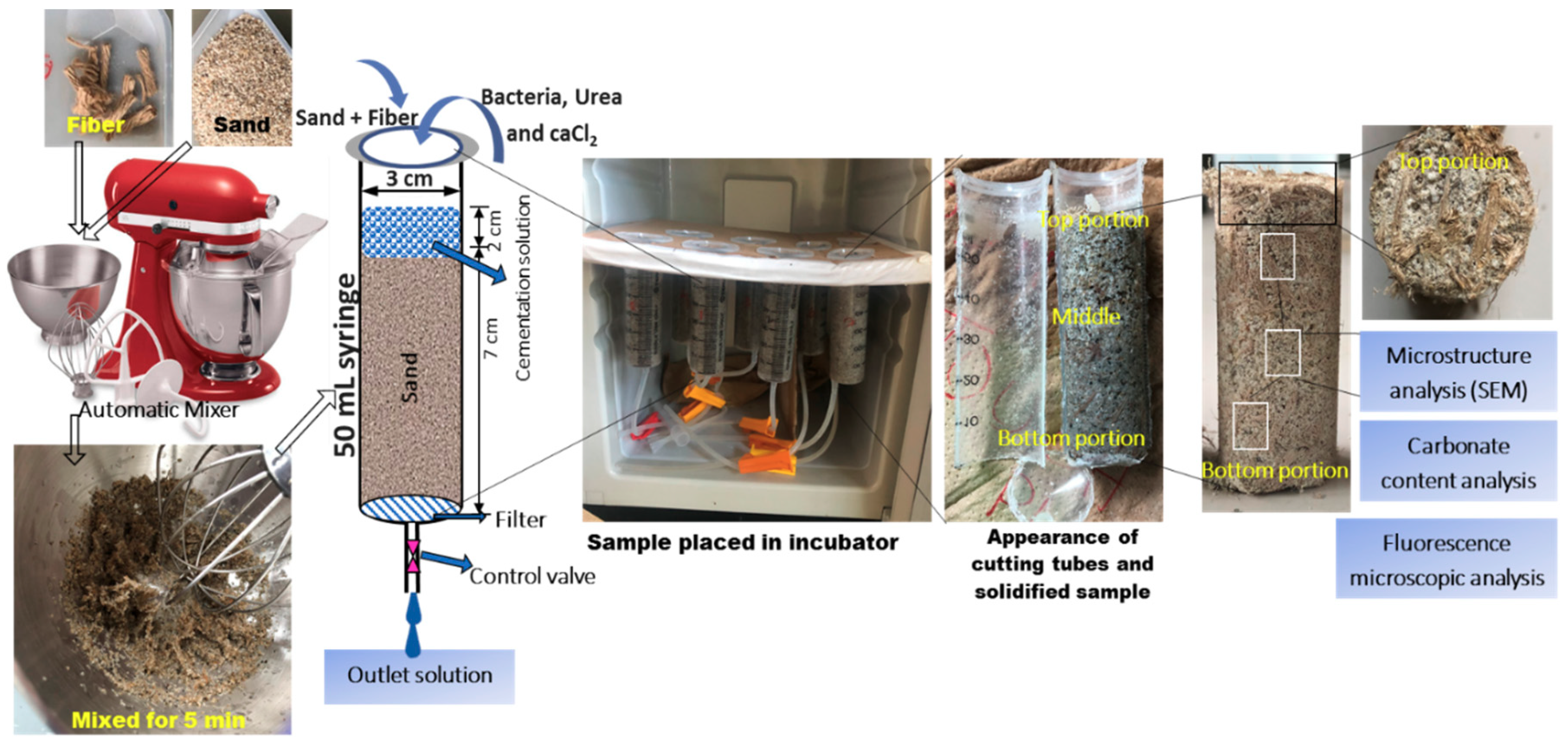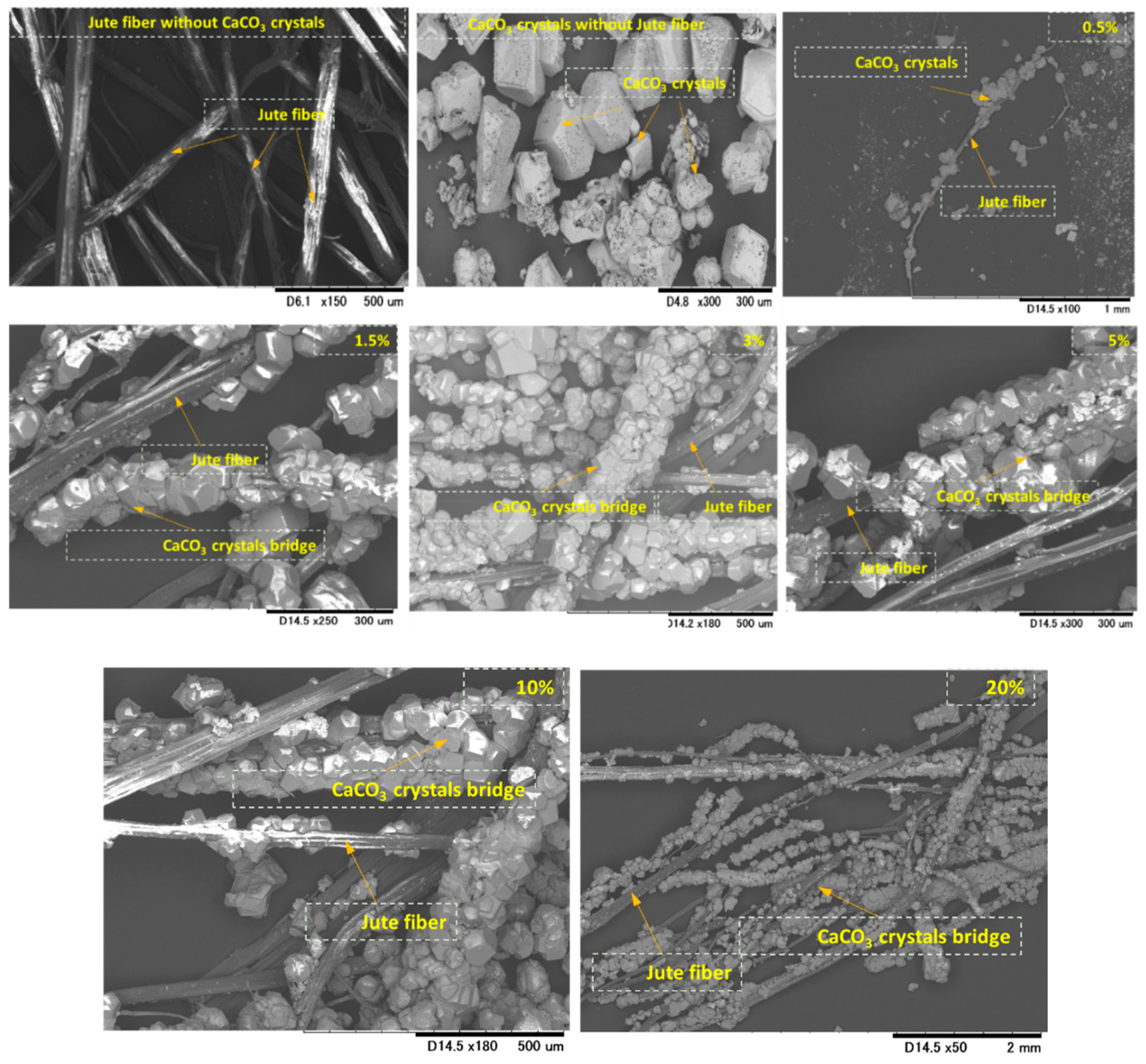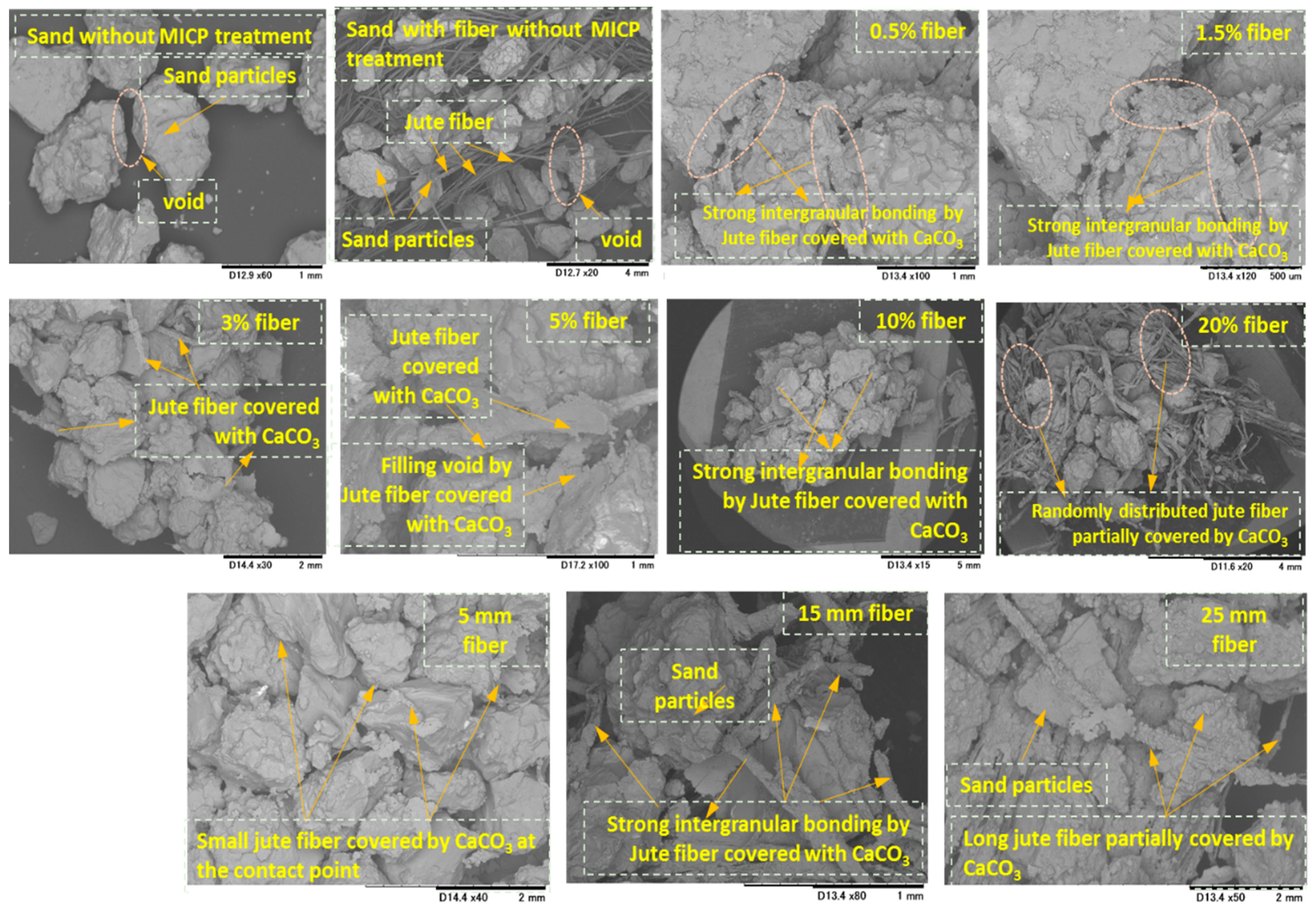The Influence of the Addition of Plant-Based Natural Fibers (Jute) on Biocemented Sand Using MICP Method
Abstract
1. Introduction
2. Materials and Methods
2.1. Fiber
2.2. Microorganisms and Soil Properties
2.3. Effects of Jute Fibers on the Process of CaCO3 Precipitation
2.4. Sample Preparation
3. Results and Discussion
3.1. Effects of Jute Fibers on the Process of CaCO3 Precipitation
3.2. Effects of Fiber Inclusions on Microorganisms
3.3. Variations in Strength after Fiber Inclusion in the MICP-Treated Sample
3.4. Effects of Bacterial Immobilization on CaCO3 Precipitation
3.5. Microstructure Analysis
4. Conclusions
- Jute fiber has significant effects on the microbial performance, CaCO3 precipitation pattern, and solidification of sand. Using fluorescence microscopy, the survival capacity of the microorganisms was well demonstrated to be increased by the addition of jute fiber. The addition effectively improved not only the bacterial performance, but also the mechanical characteristics (UCS and ductility) of sand. The UCS of the sample increased with increasing fiber content; however, higher fiber addition past a point was found to decrease the UCS. From the results obtained in this study, the optimum jute fiber content was 3% and the optimum length was 15 mm;
- The CaCO3 precipitation was positively correlated with the addition of jute fibers, which yielded significant improvement of the engineering properties of the soil. The SEM analysis suggested that the added jute fiber coupled well with CaCO3 (i.e., CaCO3 was attached on and along the surfaces of fibers), forming reliable bridges within the soil matrix, which tended to limit the development of failure planes within specimens. This process potentially increased the strength and toughness of the treated specimens compared to those of control biocemented specimens (without jute fibers);
- As the amount and length of jute fibers increased beyond the optimum level, the fibers tended to become entangled with each other during preparation of the samples, which hindered the entry of bacteria and reduced the space available for bacterial survival and CaCO3 formation;
- In this study, natural jute fibers were used; however, the effects of chemically treated jute fibers and the roughness of jute fibers (surface roughness) have not been investigated in detail. In order to better understand the effects of fibers on soil stabilization (considering chemical pretreatment of the fiber, fiber roughness, etc.) using the MICP process, further studies are highly recommended.
Author Contributions
Funding
Conflicts of Interest
References
- Mwandira, W.; Nakashima, K.; Kawasaki, S. Bioremediation of lead-contaminated mine waste by Pararhodobacter sp. based on the microbially induced calcium carbonate precipitation technique and its effects on strength of coarse and fine grained sand. Ecol. Eng. 2017, 109, 57–64. [Google Scholar] [CrossRef]
- Amarakoon, G.G.N.N.; Kawasaki, S. Factors Affecting Sand Solidification Using MICP with Pararhodobacter sp. Mater. Trans. 2017, 59, 72–81. [Google Scholar] [CrossRef]
- Al Imran, M.; Shinmura, M.; Nakashima, K.; Kawasaki, S. Effects of Various Factors on Carbonate Particle Growth Using Ureolytic Bacteria. Mater. Trans. 2018, 59, 1520–1527. [Google Scholar] [CrossRef]
- Gowthaman, S.; Mitsuyama, S.; Nakashima, K.; Komatsu, M.; Kawasaki, S. Biogeotechnical approach for slope soil stabilization using locally isolated bacteria and inexpensive low-grade chemicals: A feasibility study on Hokkaido expressway soil, Japan. Soils Found. 2019, 59, 484–499. [Google Scholar] [CrossRef]
- Omoregie, A.I.; Ngu, L.H.; Ong, D.E.L.; Nissom, P.M. Low-cost cultivation of Sporosarcina pasteurii strain in food-grade yeast extract medium for microbially induced carbonate precipitation (MICP) application. Biocatal. Agric. Biotechnol. 2019, 17, 247–255. [Google Scholar] [CrossRef]
- Mortensen, B.M.; Haber, M.J.; Dejong, J.T.; Caslake, L.F.; Nelson, D.C. Effects of environmental factors on microbial induced calcium carbonate precipitation. J. Appl. Microbiol. 2011, 111, 338–349. [Google Scholar] [CrossRef] [PubMed]
- Martinez, B.C.; DeJong, J.T.; Ginn, T.R.; Montoya, B.M.; Barkouki, T.H.; Hunt, C.; Tanyu, B.; Major, D. Experimental Optimization of Microbial-Induced Carbonate Precipitation for Soil Improvement. J. Geotech. Geoenvironmental Eng. 2013, 139, 587–598. [Google Scholar] [CrossRef]
- Li, L.; Zhao, Q.; Zhang, H.; Amini, F.; Li, C. A Full Contact Flexible Mold for Preparing Samples Based on Microbial-Induced Calcite Precipitation Technology. Geotech. Test. J. 2014, 37, 917–921. [Google Scholar]
- Qiu, R.; Tong, H.; Fang, X.; Liao, Y.; Li, Y. Analysis of strength characteristics of carbon fiber–reinforced microbial solidified sand. Adv. Mech. Eng. 2019, 11, 1–7. [Google Scholar] [CrossRef]
- Chen, H.J.; Peng, C.F.; Tang, C.W.; Chen, Y.T. Self-healing concrete by biological substrate. Materials 2019, 12, 4099. [Google Scholar] [CrossRef]
- Choi, S.-G.; Wang, K.; Chu, J. Properties of biocemented, fiber reinforced sand. Constr. Build. Mater. 2016, 120, 623–629. [Google Scholar] [CrossRef]
- Gowthaman, S.; Nakashima, K.; Kawasaki, S. A state-of-the-art review on soil reinforcement technology using natural plant fiber materials: Past findings, present trends and future directions. Materials 2018, 11, 553. [Google Scholar] [CrossRef] [PubMed]
- Wen, K.; Bu, C.; Liu, S.; Li, Y.; Li, L. Experimental investigation of flexure resistance performance of bio-beams reinforced with discrete randomly distributed fiber and bamboo. Constr. Build. Mater. 2018, 176, 241–249. [Google Scholar] [CrossRef]
- Islam, M.S.; Ahmed, S.J. Influence of jute fiber on concrete properties. Constr. Build. Mater. 2018, 189, 768–776. [Google Scholar] [CrossRef]
- Hejazi, S.M.; Sheikhzadeh, M.; Abtahi, S.M.; Zadhoush, A. A simple review of soil reinforcement by using natural and synthetic fibers. Constr. Build. Mater. 2012, 30, 100–116. [Google Scholar] [CrossRef]
- Zhao, G.Z.; Li, J.; Qin, S.; Zhang, Y.Q.; Zhu, W.Y.; Jiang, C.L.; Xu, L.H.; Li, W.J. Micrococcus yunnanensis sp. nov., a novel actinobacterium isolated from surface-sterilized Polyspora axillaris roots. Int. J. Syst. Evol. Microbiol. 2009, 59, 2383–2387. [Google Scholar] [CrossRef]
- Imran, M.; Kimura, S.; Nakashima, K.; Evelpidou, N.; Kawasaki, S. Feasibility Study of Native Ureolytic Bacteria for Biocementation Towards Coastal Erosion Protection by MICP Method. Appl. Sci. 2019, 9, 4462. [Google Scholar] [CrossRef]
- Fang, X.; Yang, Y.; Chen, Z.; Liu, H.; Xiao, Y.; Shen, C. Influence of Fiber Content and Length on Engineering Properties of MICP-Treated Coral Sand. Geomicrobiol. J. 2020, 37, 582–594. [Google Scholar] [CrossRef]
- Natarajan, K.R. Kinetic Study of the Enzyme Urease from Dolichos biflorus. J. Chem. Educ. 1995, 72, 556. [Google Scholar] [CrossRef]
- American Society for Testing and Materials. Standard Test Method for Rapid Determination of Carbonate Content of Soils; ASTM D4373-14; ASTM International: West Conshohocken, PA, USA, 2014. [Google Scholar]
- Gupta, M.K.; Srivastava, R.K.; Bisaria, H. Potential of Jute Fibre Reinforced Polymer Composites: A review ISSN 2277-7156 Review Article Potential of Jute Fibre Reinforced Polymer Composites: A Review. Int. J. Fiber Text. Res. 2015, 5, 30–38. [Google Scholar]
- Choi, S.-G.; Hoang, T.; Alleman, E.J.; Chu, J. Splitting Tensile Strength of Fiber-Reinforced and Biocemented Sand. J. Mater. Civ. Eng. 2019, 31, 06019007. [Google Scholar] [CrossRef]
- Li, M.; Li, L.; Ogbonnaya, U.; Wen, K.; Tian, A.; Amini, F. Influence of fiber addition on mechanical properties of MICP-treated sand. J. Mater. Civ. Eng. 2016, 28, 04015166. [Google Scholar] [CrossRef]
- Al Qabany, A.; Soga, K.; Santamarina, C. Factors affecting efficiency of microbially induced calcite precipitation. J. Geotech. Geoenvironmental Eng. 2012, 138, 992–1001. [Google Scholar] [CrossRef]
- Shao, W.; Cetin, B.; Li, Y.; Li, J.; Li, L. Experimental Investigation of Mechanical Properties of Sands Reinforced with Discrete Randomly Distributed Fiber. Geotech. Geol. Eng. 2014, 32, 901–910. [Google Scholar] [CrossRef]
- Lei, X.; Lin, S.; Meng, Q.; Liao, X.; Xu, J. Influence of different fiber types on properties of biocemented calcareous sand. Arab. J. Geosci. 2020, 13, 317. [Google Scholar] [CrossRef]
- DeJong, J.T.; Mortensen, B.M.; Martinez, B.C.; Nelson, D.C. Bio-mediated soil improvement. Ecol. Eng. 2010, 36, 197–210. [Google Scholar] [CrossRef]
- Consoli, N.C.; Vendruscolo, M.A.; Fonini, A.; Rosa, F.D. Fiber reinforcement effects on sand considering a wide cementation range. Geotext. Geomembr. 2009, 27, 196–203. [Google Scholar] [CrossRef]
- Munshi, T.K.; Chattoo, B.B. Bacterial population structure of the jute-retting environment. Microb. Ecol. 2008, 56, 270–282. [Google Scholar] [CrossRef]
- Glöckner, F.O.; Fuchs, B.M.; Amann, R. Bacterioplankton compositions of lakes and oceans: A first comparison based on fluorescence in situ hybridization. Appl. Environ. Microbiol. 1999, 65, 3721–3726. [Google Scholar] [CrossRef]
- Tang, C.; Shi, B.; Gao, W.; Chen, F.; Cai, Y. Strength and mechanical behavior of short polypropylene fiber reinforced and cement stabilized clayey soil. Geotext. Geomembr. 2007, 25, 194–202. [Google Scholar] [CrossRef]
- DOS SANTOS, A.P.S.; CONSOLI, N.C.; BAUDET, B.A. The mechanics of fibre-reinforced sand. Géotechnique 2010, 60, 791–799. [Google Scholar] [CrossRef]
- Teng, F.; Ouedraogo, C.; Sie, Y.C. Strength improvement of a silty clay with microbiologically induced process and coir fiber. J. Geoengin. 2020, 15, 79–88. [Google Scholar]
- Zhao, Y.; Xiao, Z.; Fan, C.; Shen, W.; Wang, Q.; Liu, P. Comparative mechanical behaviors of four fiber-reinforced sand cemented by microbially induced carbonate precipitation. Bull. Eng. Geol. Environ. 2020, 79, 3075–3086. [Google Scholar] [CrossRef]
- Nafisi, A.; Montoya, B.M.; Evans, T.M. Shear Strength Envelopes of Biocemented Sands with Varying Particle Size and Cementation Level. J. Geotech. Geoenvironmental Eng. 2020, 146, 04020002. [Google Scholar] [CrossRef]
- Harkes, M.P.; van Paassen, L.A.; Booster, J.L.; Whiffin, V.S.; van Loosdrecht, M.C.M. Fixation and distribution of bacterial activity in sand to induce carbonate precipitation for ground reinforcement. Ecol. Eng. 2010, 36, 112–117. [Google Scholar] [CrossRef]
- Urrea-Ceferino, G.E.; Rempe, N.; dos Santos, V.; Savastano Junior, H. Definition of optimal parameters for supercritical carbonation treatment of vegetable fiber-cement composites at a very early age. Constr. Build. Mater. 2017, 152, 424–433. [Google Scholar] [CrossRef]




















| Fiber Type | Thickness | Length (Total) | Weight | Type | Moisture Content | Colour |
|---|---|---|---|---|---|---|
| Jute | 2 mm | 510 m | 900 g | Roll | 3.4% | Golden-brown |
| Fiber Content [(%) mm] | CaCl2 (M) | Urea (M) | Bacterial OD600 | Incubation Time (h) | Incubation Temperature (°C) |
|---|---|---|---|---|---|
| 0 | 0.5 | 0.5 | 2 | 48 | 30 |
| [(0.5) 15] | 0.5 | 0.5 | 2 | 48 | 30 |
| [(1.5) 15] | 0.5 | 0.5 | 2 | 48 | 30 |
| [(3) 15] | 0.5 | 0.5 | 2 | 48 | 30 |
| [(5) 15] | 0.5 | 0.5 | 2 | 48 | 30 |
| [(10) 15] | 0.5 | 0.5 | 2 | 48 | 30 |
| [(20) 15] | 0.5 | 0.5 | 2 | 48 | 30 |
| Fiber Length [(mm) %] | CaCl2 (M) | Urea (M) | Bacterial OD600 | Incubation Time (h) | Incubation Temperature (°C) |
|---|---|---|---|---|---|
| 0 | 0.5 | 0.5 | 2 | 48 | 30 |
| [(5) 3] | 0.5 | 0.5 | 2 | 48 | 30 |
| [(15) 3] | 0.5 | 0.5 | 2 | 48 | 30 |
| [(25) 3] | 0.5 | 0.5 | 2 | 48 | 30 |
| Cases | Fiber Content [(%) mm] | Cementation Solution Injection | Bacterial Injection | Bacterial OD600 | Curing Temperature (°C) | Curing Days |
|---|---|---|---|---|---|---|
| 0 | 0 | Everyday | Twice * | 6 | 30 | 14 |
| 1 | [(0.5) 15] | Everyday | Twice * | 6 | 30 | 14 |
| 2 | [(1.5) 15] | Everyday | Twice * | 6 | 30 | 14 |
| 3 | [(3) 15] | Everyday | Twice * | 6 | 30 | 14 |
| 4 | [(5) 15] | Everyday | Twice * | 6 | 30 | 14 |
| 5 | [(10) 15] | Everyday | Twice * | 6 | 30 | 14 |
| 6 | [(20) 15] | Everyday | Twice * | 6 | 30 | 14 |
| Cases | Fiber Length [(mm) %] | Cementation Solution Injection | Bacterial Injection | Bacterial OD600 | Curing Temperature (°C) | Curing Days |
|---|---|---|---|---|---|---|
| 0 | 0 | Everyday | Twice * | 6 | 30 | 14 |
| 1 | [(5) 3] | Everyday | Twice * | 6 | 30 | 14 |
| 2 | [(15) 3] | Everyday | Twice * | 6 | 30 | 14 |
| 3 | [(25) 3] | Everyday | Twice * | 6 | 30 | 14 |
| Fiber Content (%) | Unit Weight (g) | Vs (km/s) | Vp (km/s) | UCS (MPa) | Average CaCO3 (%) |
|---|---|---|---|---|---|
| 0 | 65.6 | 0.92 | 1.12 | 0.5 | 2.4 |
| 0.5 | 64.2 | 0.87 | 1.22 | 1.5 | 9.3 |
| 1.5 | 63.5 | 0.95 | 1.24 | 1.4 | 11.88 |
| 3 | 60.1 | 0.92 | 1.25 | 1.6 | 13.29 |
| 5 | 61.5 | 0.9 | 1.23 | 1.3 | 7.9 |
| 10 | 60.2 | 0.99 | 1.22 | 0.8 | 4.6 |
| 20 | 59.9 | 0.93 | 1.24 | 0.3 | 3.29 |
| Fiber length (mm) | |||||
| 5 | 62.4 | 0.92 | 1.28 | 0.5 | 2.4 |
| 15 | 61.9 | 0.87 | 1.12 | 1.3 | 8.4 |
| 25 | 63.6 | 0.95 | 1.27 | 1.4 | 9.7 |
© 2020 by the authors. Licensee MDPI, Basel, Switzerland. This article is an open access article distributed under the terms and conditions of the Creative Commons Attribution (CC BY) license (http://creativecommons.org/licenses/by/4.0/).
Share and Cite
Imran, M.A.; Gowthaman, S.; Nakashima, K.; Kawasaki, S. The Influence of the Addition of Plant-Based Natural Fibers (Jute) on Biocemented Sand Using MICP Method. Materials 2020, 13, 4198. https://doi.org/10.3390/ma13184198
Imran MA, Gowthaman S, Nakashima K, Kawasaki S. The Influence of the Addition of Plant-Based Natural Fibers (Jute) on Biocemented Sand Using MICP Method. Materials. 2020; 13(18):4198. https://doi.org/10.3390/ma13184198
Chicago/Turabian StyleImran, Md Al, Sivakumar Gowthaman, Kazunori Nakashima, and Satoru Kawasaki. 2020. "The Influence of the Addition of Plant-Based Natural Fibers (Jute) on Biocemented Sand Using MICP Method" Materials 13, no. 18: 4198. https://doi.org/10.3390/ma13184198
APA StyleImran, M. A., Gowthaman, S., Nakashima, K., & Kawasaki, S. (2020). The Influence of the Addition of Plant-Based Natural Fibers (Jute) on Biocemented Sand Using MICP Method. Materials, 13(18), 4198. https://doi.org/10.3390/ma13184198









